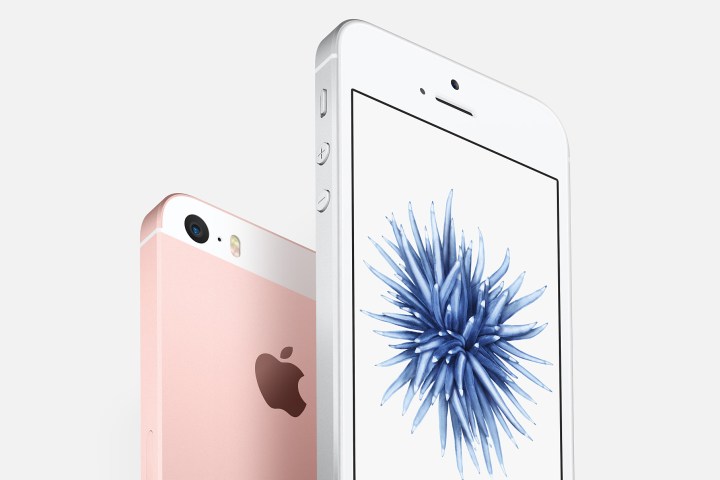
The iPhone SE is the cheapest new iPhone you’d actually want to buy.
Now we’ve got the iPhone SE, a brand-new 4-inch phone that’s not a feeble follow-up to the kid-friendly iPhone 5C, but an exciting phone that stands proud alongside the iPhone 6S and 6S Plus. It also shares an almost identical specification sheet, which is to say it’s very, very powerful. The only thing that’s not huge about the iPhone SE is its screen.
Its relative uniqueness isn’t going to last, though. There’s an excellent chance that Apple is about to reverse the trend toward face-sized screens on high-end phones, and spawn a whole new generation of petite phones that boast massive power and small screens.
Newcomers and upgraders
Tim Cook spelled out the reason for the iPhone SE’s existence very clearly. It’s an essential gateway into iPhone ownership for a lot of people. In China — a very important market, where Apple’s revenue rose throughout 2015 — the 4-inch iPhone is the entry point for the majority of owners. At the moment, they’re using either a 5S or a 5C, and while competent, those phones are leagues behind the 6S in terms of performance and ability.
Apple wants your first iOS experience to be a good one, and if it’s on a 4-inch phone, then it had better be a decent 4-inch phone. The 5C was a wimpy, weak phone with an older processor that could not stand the test of time. What’s more, if you chose a 5C, then there was no Touch ID sensor for Apple Pay — a major source of revenue, and a real selling point, thanks to its convenience. No matter how you slice it, due to their age, the 5S and certainly the 5C struggle to keep pace with technological advances driven by the 6S, and soon, the iPhone 7.

There’s also another reason that remained unspoken at the event. Apple did mention it while reporting earnings in October last year. Tim Cook commented that two-thirds of iPhone owners who bought their phones prior to 2014, when the iPhone 6 was introduced, haven’t upgraded. While the reason could be monetary, it may also be because they don’t want a phone with a larger screen. The iPhone SE may be exactly what these die-hards are waiting for.
The SE will never be Apple’s biggest selling phone — the 30 million 4-inch iPhones sold in 2015 isn’t much compared to the more than 230 million sold in total — but there seems to be demand for a smaller iPhone, so why shouldn’t Apple fill that need?
Maintaining the now instantly recognizable iPhone 5S shape gives the SE an identity all of its own.
Android fans may see at it as a hard sell, especially when many high-end Android phones — including the Moto X Play and the OnePlus 2 — have dreamy spec sheets. In the

Crucially, Apple has also done the right thing with the design. It could have given the SE an iPhone 6S makeover, but this would have been a huge mistake. Why? Because it would have looked like hundreds of other phones in the process. Maintaining the now instantly recognizable iPhone 5S shape gives the SE an identity all of its own. Design teams have forgotten about the iPhone 5 shape, so no-one is really copying it much anymore. I imagine there are Android manufacturers scrabbling around in the parts bin for abandoned iPhone 5-esque design mockups, desperate to stuff a Snapdragon 820 and 4GB of RAM inside, then get it out the door.
If this happens, it’ll prove once again Apple’s ability to dictate trends.
Small screens, big power
It’s easy to groan at the thought of another swathe of iPhone imitators ready to hit stores, but it’s actually not terrible at all. At least they’ll be different from what has come before, and we may really see another small smartphone with the best tech 2016 has to offer inside its body. Consider this: A 4-inch, 1080p screen gives a delectable 550ppi pixel density, while an (admittedly unfeasible) 1440p panel raises that to 734ppi.
I don’t know about you, but the idea of an Android phone with a super-sharp screen, a Qualcomm Snapdragon 820, masses of RAM, and other killer specs packed into a small device with a 4-inch screen sounds damn exciting. A lot of people have been hankering after a small but mighty smartphone for years, and now, there’s a reason to build one. Yes, it’s depressing to think it takes Apple making a move to bring the industry back to the idea of making pocketable phones, but we’ll take what we can get.
If you dismissed the iPhone SE as a relic from yesteryear, brought up to date only for nostalgics and paupers, then think again. The diminutive phone could be responsible for a big, and very welcome change. There may be a lot more small phones coming soon.
What do you think? Is the iPhone SE stupid or genius?
Posted by Digital Trends on Tuesday, March 22, 2016
Editors' Recommendations
- This one Apple Fitness feature completely changed how I exercise
- An Apple insider just revealed how iOS 18’s AI features will work
- iPhone 16: news, rumored price, release date, and more
- iPhone SE 4: news, rumored price, release date, and more
- 3 reasons why I’ll actually use Anker’s new iPhone power bank




